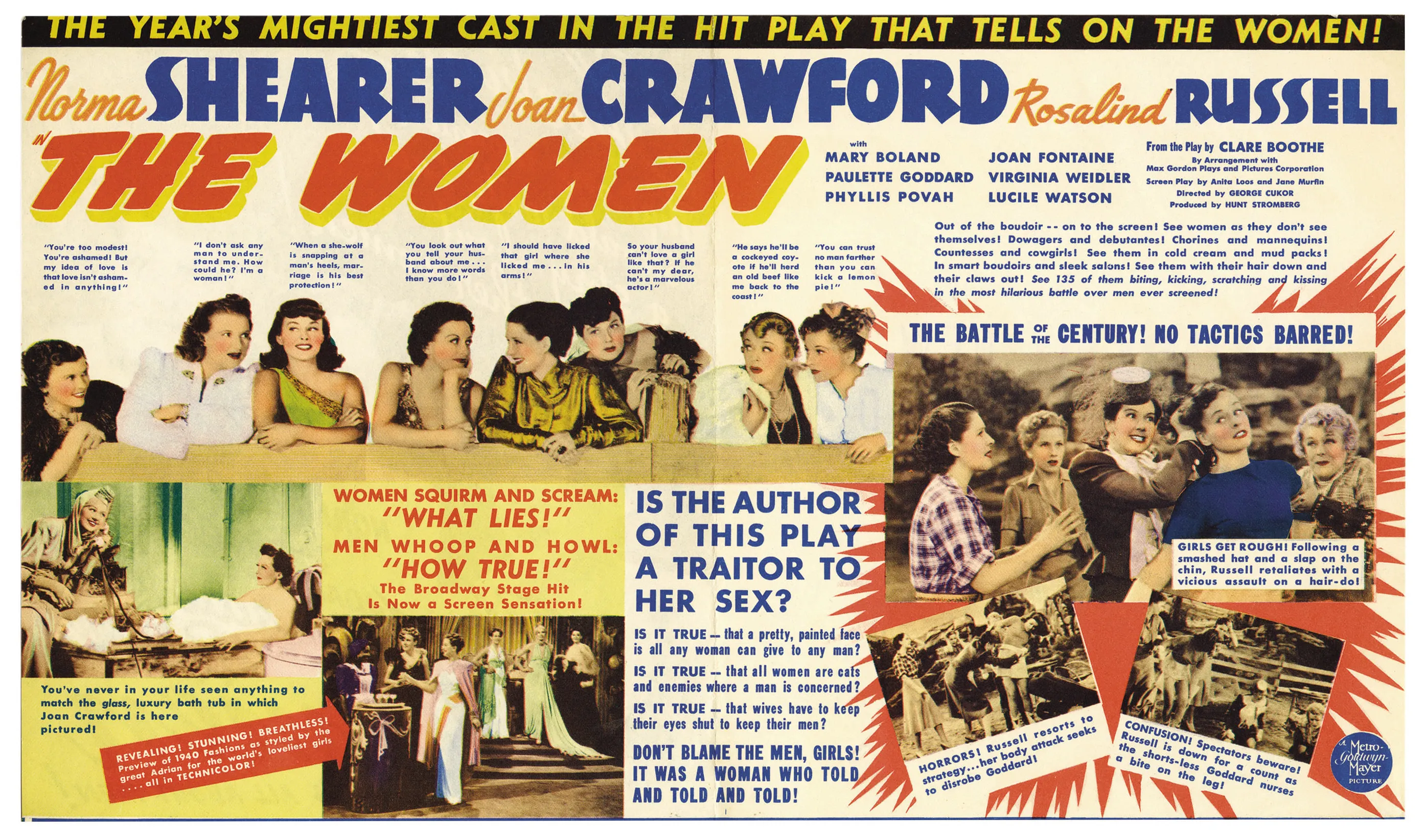When “The Women” was released in 1939, MGM’s publicists went to town. They stressed the novelty of the movie. It boasted an all-female cast. As the publicists noted, the production team went to great lengths to ensure there was no male onscreen. Even the dogs in the film were certifiably female. Despite the preponderance of women onscreen, however, “The Women” probably could not be considered a feminist film classic. The publicists may have made bizarre claims about casting, but the tagline that they used was perceptive— “‘The Women’ is all about men!”
Although they are absent, men play an outsized role in the movie. Amazingly, this all-female film does not pass the Bechdel test, a diagnostic used to determine whether a story is sexist. While the movie certainly has women who talk to each other, they cannot stop talking about their husbands. Mary (Norma Shearer) is happily married to Stephen, but then he runs off with an avaricious perfume saleswoman (Joan Crawford). Her friends Sylvia (Rosalind Russell) and Peggy (Joan Fontaine) are also saddled with less-than-satisfactory spouses. They spend scenes describing their partners’ shortcomings. Yet, their remarks are so colorful that it seems reductive to call this film regressive. While “The Women” may not offer a particularly profound commentary on relationships between the sexes, it does display Hollywood craftsmanship at its highest level.
A few minutes into “The Women,” it becomes clear that the film was never intended to be a realist examination of obstacles women face. All of the characters in the film are immensely wealthy. They have maids to cook and clean, so they can spend their days at spas or in each other’s salons. Still, the actual elite do not converse in such catty language. The dialogue in the film glitters with wit. A few examples culled from the film— “I wouldn’t trust my husband on Alcatraz, the mouse,” “Can you believe that? He almost stood me up for his wife,” “There’s a name for you ladies, but it isn’t used in high society.”
Lines like these were the work of the playwright Clare Boothe Luce and the screenwriter Anita Loos. Although their subject was the shallow lives of socialites, both were highly unconventional women. Luce was a leading figure in Republican politics. In 1943, a few years after “The Women” was released, Luce would be elected to the House of Representatives. She would later serve as the U.S. ambassador to Italy and Brazil.
While Loos never left show business, she also had a distinguished career. When the pioneering filmmaker D.W. Griffith hired her as a scriptwriter in 1912, she became one of the first women to play a major role in the movies. She wrote 105 scripts for Griffith in four years. As Griffith’s influence waned and the sound film emerged, Loos continued working at a prodigious pace. Not only did she write screenplays for mogul Irving Thalberg at MGM, but she also found time to author a classic American novel— “Gentlemen Prefer Blondes,” which would later be adapted into a hit Broadway musical and an iconic film starring Marilyn Monroe.
Luce and Loos’ dialogue is a testament to their talents, but perhaps their pithy lines have larger implications. The women talk about their marital predicaments with Luce and Loos’ sharp acumen, so they never become vacuous. Even as they adhere to traditional gender roles, the characters in the film remain idiosyncratic individuals.
The actresses’ performances also serve to make these women much more than stereotypes. Much of the writing on this film focuses on the feuds between divas. Norma Shearer, Rosalind Russell and Joan Crawford were all determined to steal the picture. For me, Crawford has the juiciest role and gives the most memorable performance. She plays the gold digger who has married into this well-to-do milieu. Although Crawford is dressed in the choicest mink, her slouched posture and her hard-edged voice remind us of her character’s impoverished upbringing. Shearer, however, is almost as incredible. While she starts the movie as the paragon of womanhood and domesticity, by the end of the film, she has become as sly and manipulative as her compatriots. If Shearer remains restrained, Russell’s performance is so energetic and exaggerated that it borders on camp or slapstick comedy. Although they are all playing wives and mothers, their diverse personas suggest that there is not simply one model of femininity.
George Cukor was chosen to direct “The Women” because MGM executives thought he could make these varied performances cohere into a unified film. He was known as a “woman’s director.” The term was halfway between a compliment and a slur. Many of Hollywood’s leading ladies genuinely enjoyed working with him, but the label also pointed to his gay identity. The excellence of the actresses onscreen speaks to his skill in directing performances, but the film also contains some subtle indications of homosexuality. One of the women is an unmarried writer who dresses in a man’s suit. In a later scene, Rosalind Russell soaps down Joan Crawford’s back in the bathtub. Beyond these hints of lesbianism, it isn’t difficult to see “The Women” as actually a coterie of drag queens, all obsessed with their love lives and all trying to one-up each other. The film quickly attracted a gay following. As the critic Christopher Harrity writes, for gay men of a certain generation, “if you heard a man quoting the film, you knew you were among friends.”
For viewers like Harrity, “The Women” was more than a cliched exploration of femininity. Then again, even viewers who are not queer can appreciate the work of Luce, Loos, the actresses and Cukor. Ultimately, perhaps “The Women” is not about men at all, but about the skill of men and women who made it.
Contact Amir Abou-Jaoude at amir2 ‘at’ stanford.edu.
